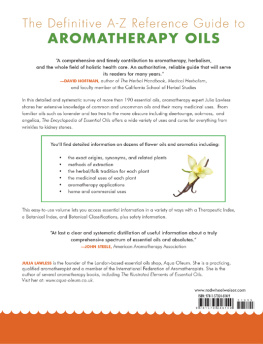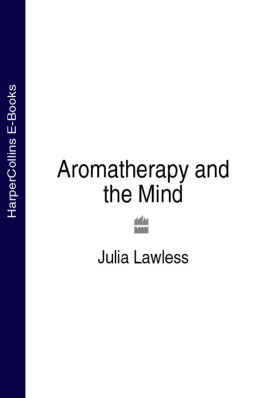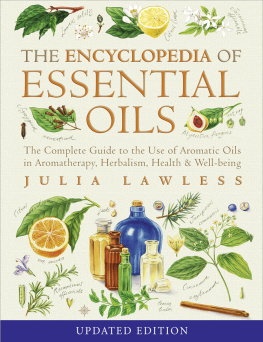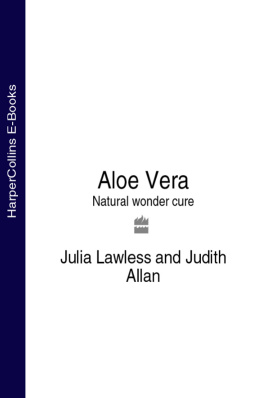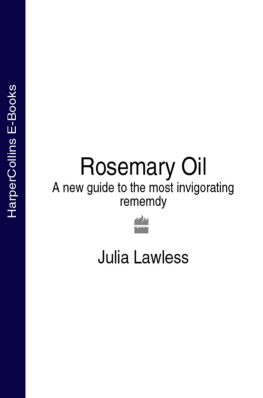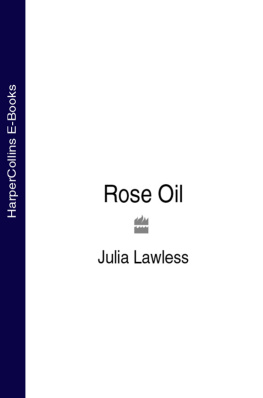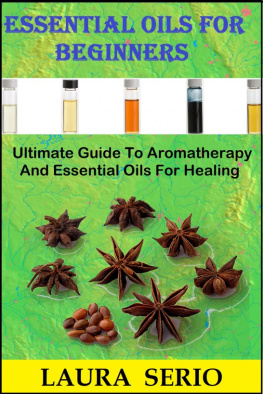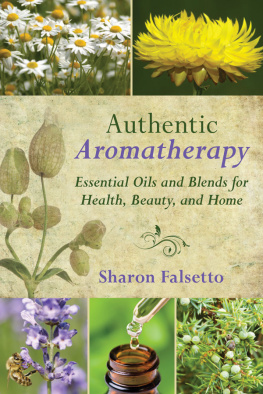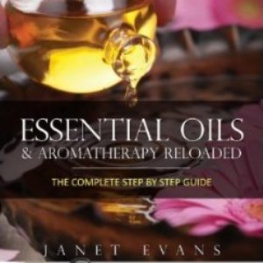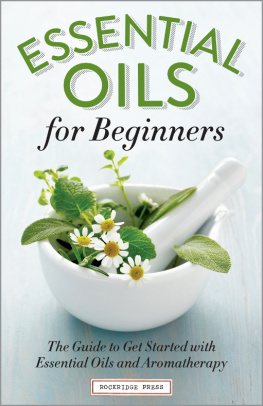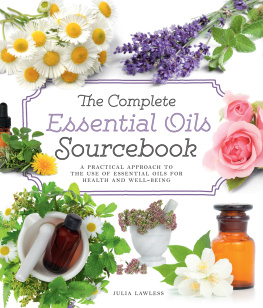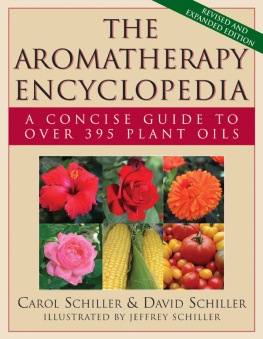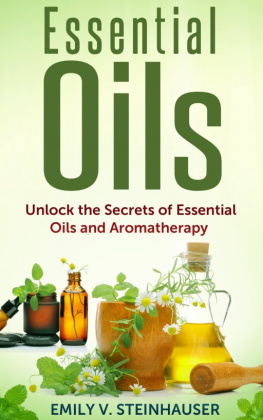
Dedication
To my mother, Kerttu
My own interest in essential oils and herbal remedies derives from the maternal side of my family who came from Finland, where home simples retained popularity long after they had vanished from most parts of Britain. My Finnish grandmother knew a great deal about herbs and wild plants which she passed on to my mother, as she recalls:
Mamas most important herb was parsley, which along with dill, marjoram, hops and others, were dried in bunches in the autumn, dangling at the ends of short lengths of cotton, all strung on a long length of thin rope stretching right across the kitchen stove. As scents are very evocative for remembering old things, I remember it so well the strong and heady smell emanating from these herbs when they were hung up, and the stove was warm.
Later, as a biochemist, my mother became involved with the research of essential oils and plants, and helped inspire in me a fascination for herbs and the use of natural remedies. Without her early enthusiasm and guidance, Im sure this book would never have been written.
In 1992 the first edition of this book was published in the UK. Since then it has been translated into many languages as well being released in several different formats, including an illustrated edition. With this new edition, I am very glad to have the opportunity to update my original work and add a few words to this preface.
In the twenty-year period since the original publication of The Encyclopedia of Essential Oils, the use of essential oils, together with the practice of aromatherapy in the West has undergone a radical transformation. At the beginning of the 1990s, aromatherapy was still considered a fringe practice and the use of essential oils in the home was by no means widespread. However, as scientific trials and clinical research have continued to confirm the potentiality of essential oils, they have become increasingly respected within the medical arena. This has been accompanied by a steady increase of public interest in holistic therapies and a sociological trend towards embracing all things natural over the past two decades in Europe and the United States.
Nowadays, aromatherapy treatments are widely available and often offered in hospitals, while essential oils can be purchased in every town. This change in attitude has bought so many benefits, but it is worth also considering the dangers that have emerged with the commercialization of aromatherapy. Although essential oils are all wholly natural substances, they can be subject to adulteration, so it is important to always buy them from a reputable supplier (see page 198). It is also vital to check that any specific safety guidelines are followed with care at home. It is my hope that this new edition brings fresh life to the multifaceted and multicultural study of essential oils and to the field of contemporary aromatherapy.
The Encyclopaedia of Essential Oils is divided into two parts:
Part I is a general introduction to aromatics, showing their changing role throughout history, from the ritual part they played in ancient civilizations, through medieval alchemy, to their modern day applications in aromatherapy, herbalism and perfumery.
Part II is a systematic survey of over 160 essential oils shown in alphabetical order according to the common name of the plants from which they are derived. Detailed information on each oil includes its botanical origins, herbal/folk tradition, odour characteristics, principal constituents and safety data, as well as its home and commercial uses.
This book can be approached in several ways:
1. It can be employed as a concise reference guide to a wide range of aromatic plants and oils, in the same way as a traditional herbal.
2. It can be used a self-help manual, showing how to use aromatherapy oils at home for the treatment of common complaints and to promote well-being.
3. It can be read from cover to cover as a comprehensive textbook on essential oils, shown in all their different aspects.
1. When using the book as a reference guide to essential oils, the name of the plant or oil may be found in the Botanical Index at the back of the book, where it is listed under:
a) its common name: for example, frankincense;
b) its Latin or botanical term: Boswellia carteri;
c) its essential oil trade name: olibanum;
d) or by its folk names: gum thus.
Other varieties, such as Indian frankincense (Boswellia serrata), may be found in the Botanical Classification section under their common family name Burseraceae, along with related species such as elemi, linaloe, myrrh and opopanax. Less common essential oils, such as blackcurrant (which is used mainly by the food industry), do not appear in the main body of the book, but are included in the Botanical Classification section under their common family name, in this case Grossulariaceae.
2. When using the book as a self-help manual on aromatherapy, it is best to consult the Therapeutic Index at the end of the book, where common complaints are grouped according to different parts of the body:
- Skin Care
- Circulation, Muscles and Joints
- Respiratory System
- Digestive System
- Genito-urinary and Endocrine Systems
- Immune System
- Nervous System
If for example, we have been working long hours at a desk and have developed a painful cramp in our neck, we should turn to the section on Circulation, Muscles and Joints where we find the heading Muscular Cramp and Stiffness. Of the essential oils which are listed, those shown in italics are generally considered to be the most useful and/or readily available, in this case allspice, lavender, marjoram, rosemary and black pepper.
The choice of which oil to use depends on what is to hand, and on assessing the quality of each oil by consulting their entry in Part II of the book. Special attention should be paid to the Safety Data on each oil: both allspice and black pepper are known to be skin irritants if used in high concentration; rosemary and marjoram should be avoided during pregnancy; rosemary should not be used by epileptics at all. On the basis of our assessment, we may choose to use lavender, marjoram and a little black pepper which would make an excellent blend. Some of the principles behind blending oils can be found in Chapter 5, Creative Blending.
The various methods of application are indicated by the letters M, massage; C, compress; B, bath etc. Turn to Chapter 4, How to Use Essential Oils at Home, where you will find instructions on how to make up a massage oil or compress, and how many drops of oil to use in a bath. Further information on how essential oils work in specific cases can be found in Chapter 3, The Body Actions and Applications.
3. Used as a comprehensive textbook, The Encyclopaedia of Essential Oils provides a wealth of information about the essential oils themselves in all their various aspects, including their perfumery and flavouring applications. It shows the development of aromatics through history and the relationship between essential oils and other herbal products. It defines different kinds of aromatic materials and their methods of extraction, giving up-to-date areas of production. In addition, it includes information on their chemistry, pharmacology and safety levels. The Actions ascribed to each plant refer either to the properties of the whole herb, or to parts of it, or to the essential oil. Difficult technical terms, mainly of a botanical or medical nature, are explained in the
Next page
